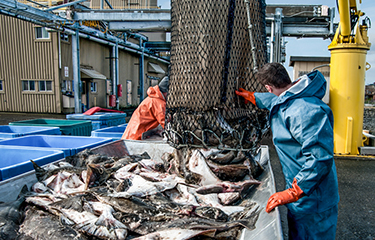Investors pushing owner-operators out of Canada’s Pacific halibut fishery

In Canada’s Pacific halibut fishery, the introduction of an individual transferable quota catch-share system in the 1990s has given rise to a new fisheries investor class, while pushing owner-operators off the water.
Danielle Edwards knows this intimately, both as an academic, and because she hails from a fishing family in a small community on the west coast of Vancouver Island. Her fishing lineage goes back several generations on both her mother's and father's side; today, her father and brother still ply the water, as do some uncles and cousins.
Edwards, who is a doctoral student at the University of British Columbia, documented ownership trends in Canada’s Pacific halibut fishery in a recent study published in Marine Policy, finding that owner-operator halibut fishermen in British Columbia have been increasingly marginalized under the fishery's individual transferable quota catch share system, pushed out by investors.
In 1991, the year the ITQ system was first introduced, owner-operators owned and caught 90 percent of the halibut. Twenty-five years later, in 2016, owner-operators caught 45 percent of the halibut and owned just 15 percent of the quota. In addition, owner-operators also hold just five of 12 seats set aside for license holders in the advisory committee process. Investors hold the rest.
Halibut is one of the highest-value fisheries in British Columbia; In 2016, the landed value was CAN 58.3 million (USD 44.3 million, EUR 40 million), and the wholesale value was CAN 93 million (USD 70.7 million, EUR 63.8 million). The ITQ system was originally implemented with the goal of not only conserving fish populations but supporting viable fishing fleets and coastal communities, equitably distributing the benefits of fishing. But the system isn't living up to those goals, according to Edwards.
"When the quota is not owned by the people who are fishing it, you are not aligning the incentives with the people on the water," Edwards told SeafoodSource. "The people fishing on the water are, by and large, renters."
Permanent access rights are being kept by investors to generate income without having to actually participate in the fishery, according to the study. The majority of operators in the fleet in 2016 had minimal ownership in the fishery, and faced significant pressure to maximize catch at the lowest possible cost due to high lease prices.
"For more than 15 years, the only people who have entered the fishery own only very small amounts of quota because it's very expensive to buy," Edwards said. The price of the quota can approach 90 percent of the landed value, she added. "You can barely break even at that point, or you're even losing money at times."
Over time as the original grantees of the quota leave the fishery, they haven't sold that quota to other, more efficient operators. Instead, they've leased that quota. At the same time, outsiders have bought quota as an investment. Most of the investors, Edwards said, are from urban areas around Vancouver and Victoria, but it’s difficult to know what the lease prices are, since there is no public registry of lease prices in British Columbia.
Investors also don't contribute to the development of the fishery, neglecting to invest in boats, equipment, coastal infrastructure, or new technologies.
"With so much wealth of the fishery being used to pay for all manner of interests unrelated to the fishery, we're already seeing that boats are not getting the maintenance they need," Edwards said. "That whole family- and small-business coastal community infrastructure starts to get lost."
The Canadian Pacific halibut first transitioned to individual quotas in 1991, with the initial allocation based on license length and catch history. Individual transferable quotas were adopted in 1993, and full and unlimited transferability, including permanent transfers, were established in 1999. Unlike in the Alaska Pacific halibut fishery and many Canadian east coast fisheries, the British Columbia halibut fishery has no restrictions on quota ownership or requirements for owner-operators.
In separate study, Edwards found that even though processors own less than 10 percent of the halibut quota, they're able to control more than half of it through re-leasing. Processors are increasingly acting as hubs for leasing activity, shifting the balance of power in the fishery, according to the study.
Edwards predicts that halibut quota ownership by owner-operators will continue to decline, unless reforms are implemented, such as requirements for owners to be on board vessels or restrictions on how much quota an individual can own.
"[Quota] is going into the pockets of people who own quota as an investment," Edwards said. "Is that sustainable and healthy over the long run? Evidence suggests no it's not. You're not seeing reinvestment into fishing vessels and gears. We're losing facilities in British Columbia for building fishing boats.”
Photo courtesy of Earl D. Walker/Shutterstock






Share